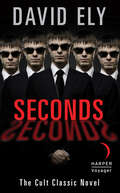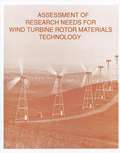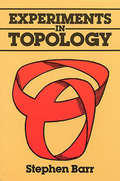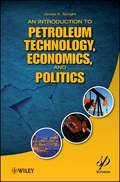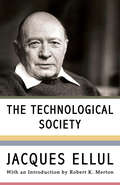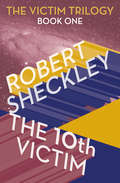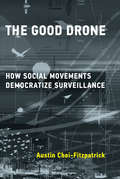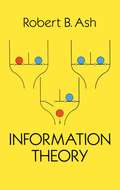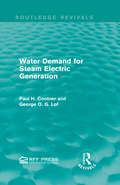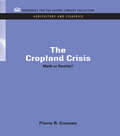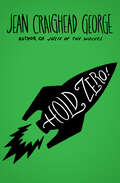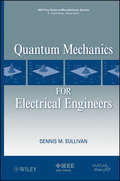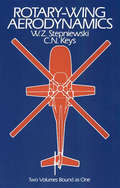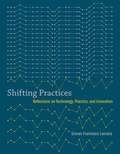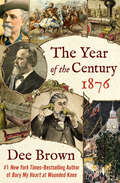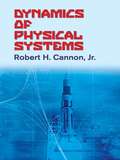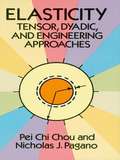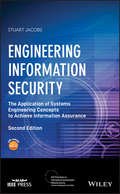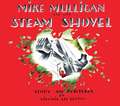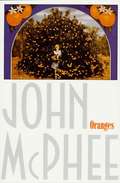- Table View
- List View
Seconds
by David ElyThe cult classic sci-fi thriller. What would you give up for a second chance?Antiochus Wilson is completely and utterly bored with his life, until he receives the call that changes everything. When the voice on the other end of the line promises him excitement, wealth, and happiness, he is more than a little intrigued.Arriving at a hastily scrawled address, Wilson discovers a mysterious and exclusive organization that offers its clients whole new lives . . . for a price. The organization arranges for a client's demise or disappearance and outfits each with a new body in which to begin again. But there's no turning back, and no room for second-guessing. When Wilson begins to question his new circumstances and pushes some very well-established boundaries a bit too far for the organization's comfort, his second chance may just be his last.
Applied Computational Aerodynamics
by Russell M. Cummings William H. Mason Scott A. Morton David R. Mcdaniel Russell M. Cummings William H. Mason Scott A. MortonThis computational aerodynamics textbook is written at the undergraduate level, based on years of teaching focused on developing the engineering skills required to become an intelligent user of aerodynamic codes. This is done by taking advantage of CA codes that are now available and doing projects to learn the basic numerical and aerodynamic concepts required. This book includes a number of unique features to make studying computational aerodynamics more enjoyable. These include: • The computer programs used in the book's projects are all open source and accessible to students and practicing engineers alike on the book's website, www. cambridge. org/aerodynamics. The site includes access to images, movies, programs, and more • The computational aerodynamics concepts are given relevance by CA Concept Boxes integrated into the chapters to provide realistic asides to the concepts • Readers can see fluids in motion with the Flow Visualization Boxes carefully integrated into the text.
Assessment of Research Needs for Wind Turbine Rotor Materials Technology
by Committee on Assessment of Research Needs for Wind Turbine Rotor Materials TechnologyWind-driven power systems represent a renewable energy technology. Arrays of interconnected wind turbines can convert power carried by the wind into electricity. This book defines a research and development agenda for the U.S. Department of Energy's wind energy program in hopes of improving the performance of this emerging technology.
Experiments in Topology
by Stephen Barr"A mathematician named KleinThought the Moebius band was divine.Said he: 'If you glueThe edges of two,You'll get a weird bottle like mine.' " -- Stephen BarrIn this lively book, the classic in its field, a master of recreational topology invites readers to venture into such tantalizing topological realms as continuity and connectedness via the Klein bottle and the Moebius strip. Beginning with a definition of topology and a discussion of Euler's theorem, Mr. Barr brings wit and clarity to these topics:New Surfaces (Orientability, Dimension, The Klein Bottle, etc.)The Shortest Moebius StripThe Conical Moebius StripThe Klein BottleThe Projective Plane (Symmetry)Map ColoringNetworks (Koenigsberg Bridges, Betti Numbers, Knots)The Trial of the Punctured TorusContinuity and Discreteness ("Next Number," Continuity, Neighborhoods, Limit Points)Sets (Valid or Merely True? Venn Diagrams, Open and Closed Sets, Transformations, Mapping, Homotopy)With this book and a square sheet of paper, the reader can make paper Klein bottles, step by step; then, by intersecting or cutting the bottle, make Moebius strips. Conical Moebius strips, projective planes, the principle of map coloring, the classic problem of the Koenigsberg bridges, and many more aspects of topology are carefully and concisely illuminated by the author's informal and entertaining approach.Now in this inexpensive paperback edition, Experiments in Topology belongs in the library of any math enthusiast with a taste for brainteasing adventures in the byways of mathematics.
An Introduction to Petroleum Technology, Economics, and Politics
by James G. SpeightThe perfect primer for both the layperson and the engineer, for the new hire and the old hand, describing, in easy-to-understand language, one of the biggest and most lucrative industries in the world. There is only one substance known to mankind that can cause wars, influence global economies, and make entire countries rich: petroleum. One teaspoon of the stuff carries enough energy to power a ton truck up a hill. It's in the news every single day, it influences our lives in ways that we cannot fathom, and it is the most important commodity in the world. But how much does the average person, even the average engineer, know about it? This book describes the petroleum industry, in easy-to-understand language, for both the layperson and engineer alike. From the economics of searching for oil and gas to the pitfalls of drilling and production, getting it out of the ground, into pipelines, into refineries, and, finally, into your gas tank, this book covers the petroleum industry like no other treatment before. There is coverage of pricing and the economics of this very important resource, as well, which is useful not only to engineers, but to economists and, really, anyone who uses it. From jet fuel to gasoline to natural gas and plastics, petroleum is one of the integral products of our lives. We are practically bathed it in from birth, our food is protected by it, and it even has healing properties. Learn all about this incredible substance and its fascinating history and highly debated future. An Introduction to Petroleum Technology, Economics, and Politics: Gives a thorough summary of the petroleum and natural gas industry, from prospect to production to pipeline New technologies, such as directional and underbalanced drilling, are covered, in easy-to-understand language Useful not only for newcomers and laypersons, but for engineers and students, particularly those for whom English is a second language Examines the basics of pricing and valuation
Report of the Committee on Proposal Evaluation for Allocation of Supercomputing Time for the Study of Molecular Dynamics: Third Round
by National Research Council of the National AcademiesThe committee evaluated submissions received in response to a request for proposals (RFP) for Biomolecular Simulation Time on Anton, a supercomputer specially designed and built by D.E. Shaw Research (DESRES) that allows for dramatically increased molecular dynamics simulations compared to other currently available resources. During the past 2 years, DESRES has made available to the non-commercial research community node-hours on an Anton system housed at the Pittsburgh Supercomputing Center (PSC), based on the advice of previous National Research Council committees convened in the falls of 2010 and 2011.
The Technological Society
by Jacques EllulAs insightful and wise today as it was when originally published in 1954, Jacques Ellul's The Technological Society has become a classic in its field, laying the groundwork for all other studies of technology and society that have followed. Ellul offers a penetrating analysis of our technological civilization, showing how technology—which began innocuously enough as a servant of humankind—threatens to overthrow humanity itself in its ongoing creation of an environment that meets its own ends. No conversation about the dangers of technology and its unavoidable effects on society can begin without a careful reading of this book. "A magnificent book . . . He goes through one human activity after another and shows how it has been technicized, rendered efficient, and diminished in the process.&”—Harper's &“One of the most important books of the second half of the twentieth-century. In it, Jacques Ellul convincingly demonstrates that technology, which we continue to conceptualize as the servant of man, will overthrow everything that prevents the internal logic of its development, including humanity itself—unless we take necessary steps to move human society out of the environment that 'technique' is creating to meet its own needs.&”—The Nation &“A description of the way in which technology has become completely autonomous and is in the process of taking over the traditional values of every society without exception, subverting and suppressing these values to produce at last a monolithic world culture in which all non-technological difference and variety are mere appearance.&”—Los Angeles Free Press
The 10th Victim (Victim #1)
by Robert SheckleyIt&’s the twenty-first century and the ugliness of war no longer exists, except on a very personal level. Nowadays, people like Marcello Polletti, seller of Roman sunsets, and Caroline Meredith, lithe, beautiful, blond, and backed by corporate sponsors and the Roy Bell Dancers, hunt, chase, and kill one another for sport and for the entertainment of the masses—until something oddly like personal human feelings pops up to confuse the players and up the stakes as each of them seeks to kill a tenth victim and rise in the ranks of the hunters. From the very beginning of his career, Robert Sheckley was recognized by fans, reviewers, and fellow authors as a master storyteller and the wittiest satirist working in the science fiction field. Open Road is proud to republish his acclaimed body of work, with nearly thirty volumes of full-length fiction and short story collections. Rediscover, or discover for the first time, a master of science fiction who, according to the New York Times, was &“a precursor to Douglas Adams.&”
The Good Drone: How Social Movements Democratize Surveillance (Acting with Technology)
by Austin Choi-FitzpatrickHow small-scale drones, satellites, kites, and balloons are used by social movements for the greater good.Drones are famous for doing bad things: weaponized, they implement remote-control war; used for surveillance, they threaten civil liberties and violate privacy. In The Good Drone, Austin Choi-Fitzpatrick examines a different range of uses: the deployment of drones for the greater good. Choi-Fitzpatrick analyzes the way small-scale drones--as well as satellites, kites, and balloons--are used for a great many things, including documenting human rights abuses, estimating demonstration crowd size, supporting anti-poaching advocacy, and advancing climate change research. In fact, he finds, small drones are used disproportionately for good; nonviolent prosocial uses predominate.
Information Theory
by Robert B. AshExcellent introduction treats 3 major areas: analysis of channel models and proof of coding theorems; study of specific coding systems; and study of statistical properties of information sources. Appendix summarizes Hilbert space background and results from the theory of stochastic processes. Advanced undergraduate to graduate level. Bibliography.
Water Demand for Steam Electric Generation (Routledge Revivals)
by Paul H. Cootner George O. LofIn this book, first published in 1965, the authors identify the technological opportunities and costs of water recirculation and water quality adjustment in thermal plants, relating them to the possibilities for minimal expenditure and maximum efficiency in the use of water for servicing an entire region with thermal power. Water Demand for Steam Electric Generation will be of interest to students of environmental studies.
The Cropland Crisis: Myth or Reality? (RFF Agriculture and Fisheries Set)
by Pierre CrossonThis book examines the factors affecting the demand for agricultural land in the United States and the costs of meeting increasing demand. Originally published in 1982
Hold Zero!
by Jean Craighead GeorgeCraig and his friends have a big secret—they&’ve built a real, working rocket. But will the countdown to takeoff begin before they&’re discovered? Best friends Craig, Steve, Johnny, and Phil have spent months building a rocket—not some model or a toy, but a real rocket, with boosters and a launch pad and a remote control panel. Even better, they&’ve managed to pull off the whole project in secret. The boys can&’t wait to launch their rocket . . . but then their parents find out what they&’ve been up to and tell the police. When they see how sophisticated the rocket really is, the police insist on inspecting all the blueprints and calculations, and the boys find themselves in a lot of trouble. Will their project go up in smoke? This ebook features an illustrated biography of Jean Craighead George, including rare photos from the author&’s personal collection.
Hold Zero!
by Jean Craighead GeorgeCraig and his friends have a big secret—they&’ve built a real, working rocket. But will the countdown to takeoff begin before they&’re discovered? Best friends Craig, Steve, Johnny, and Phil have spent months building a rocket—not some model or a toy, but a real rocket, with boosters and a launch pad and a remote control panel. Even better, they&’ve managed to pull off the whole project in secret. The boys can&’t wait to launch their rocket . . . but then their parents find out what they&’ve been up to and tell the police. When they see how sophisticated the rocket really is, the police insist on inspecting all the blueprints and calculations, and the boys find themselves in a lot of trouble. Will their project go up in smoke? This ebook features an illustrated biography of Jean Craighead George, including rare photos from the author&’s personal collection.
Quantum Mechanics for Electrical Engineers
by Dennis M. SullivanThe main topic of this book is quantum mechanics, as the title indicates. It specifically targets those topics within quantum mechanics that are needed to understand modern semiconductor theory. It begins with the motivation for quantum mechanics and why classical physics fails when dealing with very small particles and small dimensions. Two key features make this book different from others on quantum mechanics, even those usually intended for engineers: First, after a brief introduction, much of the development is through Fourier theory, a topic that is at the heart of most electrical engineering theory. In this manner, the explanation of the quantum mechanics is rooted in the mathematics familiar to every electrical engineer. Secondly, beginning with the first chapter, simple computer programs in MATLAB are used to illustrate the principles. The programs can easily be copied and used by the reader to do the exercises at the end of the chapters or to just become more familiar with the material. Many of the figures in this book have a title across the top. This title is the name of the MATLAB program that was used to generate that figure. These programs are available to the reader. Appendix D lists all the programs, and they are also downloadable at http://booksupport. wiley. com
Review of Extraction, Processing, Properties, and Applications of Reactive Metals
by Brajendra MishraThis proceedings volume from the 1999 TMS Annual Meeting is intended to serve as a compendium on reactive metals. Specifically, this book concentrates on zirconium, hafnium, molybdenum, niobium, beryllium, and titanium. Covering different aspects of extraction and recovery, metal refining, processing, and current and potential applications of these metals, this volume serves as a valuable reference source on reactive metals.
Rotary-Wing Aerodynamics
by W. Z. StepniewskiClear, concise text covers aerodynamic phenomena of the rotor and offers guidelines for helicopter performance evaluation. Originally prepared for NASA. Prefaces. New Indexes. 10 black-and-white photos. 537 figures.
Shifting Practices: Reflections on Technology, Practice, and Innovation
by Giovan Francesco LanzaraWhat happens in an established practice or work setting when a novel artifact or tool for doing work changes the familiar work routines? Any unexpected event, or change, or technological innovation creates a discontinuity; organizations and individuals must reframe taken-for-granted assumptions and practices and reposition themselves. To study innovation as a phenomenon, then, we must search for situations of discontinuity and rupture and explore them in depth. In Shifting Practices, Giovan Francesco Lanzara does just that, and discovers that disruptions and discontinuities caused by the introduction of new technologies often reveal aspects of practice not previously observed.After discussing methodological and research issues, Lanzara presents two in-depth studies focusing on processes of design and innovation in two different practice settings: music education and criminal justice. In the first, he works with the music department of a major American university to develop Music LOGO, a computer system that allows students to explore musical structures with simple, composition-like exercises and experiments. In the second, he works with the Italian court system in the design and use of video technology for criminal trials. In both cases, drawing on anecdotes and examples as well as theory and analysis, he traces the new systems from design through implementation and adoption. Finally, Lanzara considers the researcher's role, and the relationship -- encompassing empathy, vulnerability, and temporality -- between the reflective researcher and actors in the practice setting.
The Wonderful Flight to the Mushroom Planet (Mushroom Planet #1)
by Eleanor CameronChuck and David pay a visit to the Mushroom Planet.
The Year of the Century, 1876: 1876
by Dee BrownDee Brown&’s sparkling account of a momentous year in American historyIn 1876, America was eager to celebrate its centenary, but questioned what might lie ahead. The American Republic had grown to four times its original population, and was in the midst of enormous changes. Industrialization was booming, and new energy sources were being used for fuel and power. People were suddenly less bound to agriculture, and there were revolutions in transportation and communication. It was a time of Indian wars, the first stirrings of the labor movement, and the burgeoning struggle form women&’s and other civil rights. Historian Dee Brown takes the measure of America in a rare moment of reflection on the nation&’s past, present, and future. The Year of the Century was one of Brown&’s favorites among his works. In page-turning prose, he tells of a tumultuous era and of a young nation taking stock. This ebook features an illustrated biography of Dee Brown including rare photos from the author&’s personal collection.
Dynamics of Physical Systems (Dover Civil and Mechanical Engineering)
by Dr Robert H. CannonA comprehensive text and reference for a first study of system dynamics and control, this volume emphasizes engineering concepts -- modeling, dynamics feedback, and stability, for example -- rather than mechanistic analysis procedures designed to yield routine answers to programmable problems. Its focus on physical modeling cultivates an appreciation for the breadth of dynamic systems without resorting to analogous electric-circuit formulation and analysis.After a careful treatment of the modeling of physical systems in several media and the derivation of the differential equations of motion, the text determines the physical behavior those equations connote: the free and forced motions of elementary systems and compound "systems of systems." Dynamic stability and natural behavior receive comprehensive linear treatment, and concluding chapters examine response to continuing and abrupt forcing inputs and present a fundamental treatment of analysis and synthesis of feedback control systems. This text's breadth is further realized through a series of examples and problems that develop physical insight in the best traditions of modern engineering and lead students into richer technical ground.As presented in this book, the concept of dynamics forms the basis for understanding not only physical devices, but also systems in such fields as management and transportation. Indeed, the fundamentals developed here constitute the common language of engineering, making this text applicable to a wide variety of undergraduate and graduate courses. 334 figures. 12 tables.
Elasticity: Tensor, Dyadic, and Engineering Approaches (Dover Civil and Mechanical Engineering)
by Nicholas J. Pagano Pei Chi ChouExceptionally clear text treats elasticity from engineering and mathematical viewpoints. Comprehensive coverage of stress, strain, equilibrium, compatibility, Hooke's law, plane problems, torsion, energy, stress functions, more. 114 illustrations. 1967 edition.
Engineering Information Security
by Stuart JacobsInformation security is the act of protecting information from unauthorized access, use, disclosure, disruption, modification, or destruction. This book discusses why information security is needed and how security problems can have widespread impacts. It covers the complete security lifecycle of products and services, starting with requirements and policy development and progressing through development, deployment, and operations, and concluding with decommissioning. Professionals in the sciences, engineering, and communications fields will turn to this resource to understand the many legal, technical, competitive, criminal and consumer forces and influences that are rapidly changing our information dependent society.If you're a professor and would like a copy of the solutions manual, please contact ieeepress@ieee.org.The material previously found on the CD can now be found on www.booksupport.wiley.com.
Mike Mulligan and His Steam Shovel
by Virginia Lee BurtonMike and his trusty steam shovel, Mary Anne, have a very important job. They dig deep canals for boats to travel through, cut mountain passes for trains, and hollow out cellars for big city skyscrapers- the very symbol of modern industrial America. But with progress comes new machines, and soon the inseparable duo are out of work. Mike believes that Mary Anne can dig as much in a day as a hundred men can dig in a week, and the two have one last chance to prove it and save Mary Anne from the scrap heap. What happens next in the small town of Popperville is a testament to their friendship, as well as old-fashioned hard work and ingenuity.
Oranges
by John McpheeA classic of reportage, Oranges was first conceived as a short magazine article about oranges and orange juice, but the author kept encountering so much irresistible information that he eventually found that he had in fact written a book. It contains sketches of orange growers, orange botanists, orange pickers, orange packers, early settlers on Florida’s Indian River, the first orange barons, modern concentrate makers, and a fascinating profile of Ben Hill Griffin of Frostproof, Florida who may be the last of the individual orange barons. McPhee’s astonishing book has an almost narrative progression, is immensely readable, and is frequently amusing. Louis XIV hung tapestries of oranges in the halls of Versailles, because oranges and orange trees were the symbols of his nature and his reign. This book, in a sense, is a tapestry of oranges, too--with elements in it that range from the great orangeries of European monarchs to a custom of people in the modern Caribbean who split oranges and clean floors with them, one half in each hand.
